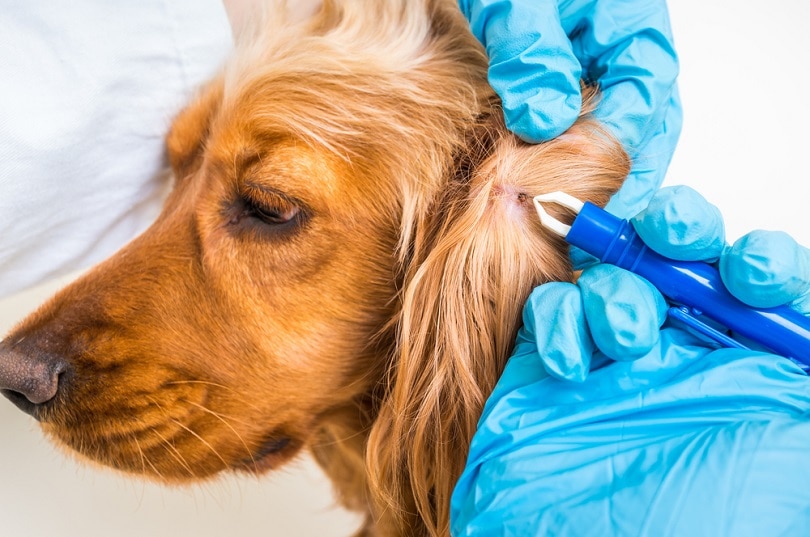In this article
Ticks are a common worry for dog parents because of the diseases they can cause. These dark-colored bloodsuckers are also adept at hiding themselves in inconspicuous places on your dog’s body, making finding them quite a feat. If you do find one of these arachnids, it can be upsetting and frightening.
Don’t try to remove the tick with your fingers—if the tick gets broken in half, it can cause irritation on your dog’s skin. Instead, what you need to do is remain calm, arm yourself with a few necessities, and remove the tick as quickly as possible. Read on to find out how to remove a tick with a household item like dish soap.

How to Get a Tick Off a Dog With Dish Soap

Before you start, you’ll need to gather a few supplies. Luckily, most of these can be found around your home.
What You’ll Need
- Tick twisters or tweezers
- Gloves
- Cotton pads
- Dish soap (Dawn or a similar brand)
- 1/2 cup of warm water
- Glass container with a lid
- Isopropyl alcohol
- Antiseptic
- An assistant to reassure your dog (if possible)
In terms of tweezers, a tick twister would be ideal, as these are made for the purpose, but if you don’t have one on hand, don’t worry—just use regular tweezers. The motion for removal is a little different with tweezers, though, which we’ll explain in our step-by-step section.

The 7 Steps to Remove a Tick With Dish Soap
As you go through these steps, have someone there to calm your dog if possible. If your dog is of the laidback variety, this may not be necessary, but other dogs may move around or get stressed. If this sounds like your dog, your assistant may need to keep them still.
- Put on your gloves to avoid the tick coming into contact with your skin.
- Pour the warm water into the plastic container, and add approximately 3 tablespoons of Dawn dish soap or a similar brand. Close the lid and shake gently.
- Soak a cotton pad in the dish soap and warm water mixture—a couple of minutes should do the trick.
- Take the cotton pad and put it over the tick. Hold it firmly in place for a few minutes. The tick should begin to loosen its hold under your grasp. If you’re lucky, the tick may detach by itself at this point. If it doesn’t, continue with the next steps.
- If you’re using a tick twister, approach the tick from underneath until its head and mouth are firmly between the tick twister’s prongs, as close to the skin as possible. Gently twist the tick upward and away from the skin, and it should come away.
- If you’re using tweezers, pinch the tick’s head and mouth as close to the skin as you can. Pull straight upward steadily to remove the tick—don’t twist or jerk the tweezers.
- When the tick has been removed, put it into a container with isopropyl alcohol and keep it in case your vet needs to check it out.


What Do You Do After Removing the Tick?
Give yourself a pat on the back—you’ve dealt with a gross and scary situation calmly and like a pro! After that, clean any wounds left behind with an antiseptic, and monitor your dog for any strange signs.
- Fever
- Loss of appetite
- Reduced energy (lethargy)
- Vomiting
- Irritation of wound
- Recurrent lameness
- Swelling or stiffness of joints
- Difficulty breathing
- Sensitivity to touch
If your dog doesn’t seem quite right in the days to come, let your vet know about the situation and arrange a visit to get your dog checked over. Take the container with the tick inside to your veterinary appointment to help your vet identify the type of tick more easily.
If you need to speak with a vet but can't get to one, head over to PangoVet. It's an online service where you can talk to a vet online and get the personalized advice you need for your pet — all at an affordable price!

How Can You Prevent Ticks?
The most important thing is to make sure you’re keeping up to date with tick and flea treatments. This is especially important if your dog spends a lot of time outside. How often you administer flea and tick treatments depends on which treatment you’re using or your vet’s advice.
Many tick and flea treatments come in tablet form and are given once a month, whereas others are in liquid form and need to be applied to the fur.

Final Thoughts
Although finding a tick can be distressing, the key is to act calmly and quickly to remove it. Remember to stay on schedule with your flea and tick treatments, and check your dog regularly with a comb for ticks. It’s a good idea to have a “tick kit” on standby with everything you need to remove a tick so you’re always ready in the event of finding one.
If you’re having trouble getting rid of a tick or have any concerns or questions about treatment, hop on the phone to your veterinary clinic, and they’ll be able to offer advice. Good luck!
Featured Image Credit: andriano.cz, Shutterstock




















